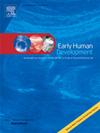音乐治疗和产前唱歌对母亲心理健康、母亲依恋和新生儿行为的贡献
IF 2.2
3区 医学
Q2 OBSTETRICS & GYNECOLOGY
引用次数: 0
摘要
怀孕期间听音乐与更好的新生儿行为有关;然而,产前唱歌对新生儿行为的影响尚不清楚。此外,子宫内母体嗡嗡声传播对胎儿和新生儿行为的影响尚不清楚。方法将24例慢产风险孕妇依次分为3组:1)对照组(CG),不进行产前唱歌;2)音乐治疗组;3)声乐训练组(VTG)。抑郁、焦虑和压力量表(DASS)和产前母亲依恋量表分别在32 GW和37 GW时使用。在出生后1周至1个月内使用DASS、产后母亲依恋量表和新生儿行为评估量表(NBAS)。结果MTG: 37 GW时产前依恋得到改善;新生儿状态范围较CG新生儿高;37 GW时评估的焦虑和压力得分较低与新生儿自主调节能力较高相关;出生后,母亲抑郁程度越低,新生儿的社会取向越高。对于VTG: 37 GW时评估的焦虑与社会取向负相关;出生后,DASS总分与自主调节呈负相关。结论mtg倾向于产前依恋和新生儿状态范围。显然,产前唱歌(在MTG和VTG都存在)可以改善产妇心理健康与新生儿社会和自我调节能力之间的关系。本文章由计算机程序翻译,如有差异,请以英文原文为准。
Contributions of music therapy and of prenatal singing to maternal mental health, maternal attachment, and neonatal behavior
Background
Listening to music during pregnancy is associated with better neonatal behavior; however, contributions of prenatal singing to neonatal behavior are still unknown. Also, contributions of acoustic propagation of maternal humming inside the womb on fetal and neonatal behavior are still not understood.
Methods
Low obstetric risk pregnant women (N = 24) were sequentially allocated into three groups: 1) control group (CG) without prenatal singing; 2) music therapy group (MTG); and 3) vocal training group (VTG). Depression, Anxiety and Stress Scales (DASS) and Antenatal Maternal Attachment Scales were applied at 32 GW and also at 37 GW. DASS, Postnatal Maternal Attachment Scales, and Neonatal Behavioral Assessment Scale (NBAS) were applied between one week and one month after birth.
Results
For MTG: prenatal attachment was improved at 37 GW; newborns range of state was higher when compared with CG newborns; lower scores of anxiety and of stress assessed at 37 GW were associated with higher neonatal autonomic regulation; after birth, lower maternal levels of depression were associated with newborns' higher social orientation. For VTG: anxiety assessed at 37 GW associated negatively with social orientation; after birth, DASS total score associated negatively with autonomic regulation.
Conclusion
MTG seems to favor prenatal attachment, and neonatal range of state. Apparently prenatal singing (present at both MTG and VTG) improves the association between maternal mental health and newborns' social and self-regulatory competencies.
求助全文
通过发布文献求助,成功后即可免费获取论文全文。
去求助
来源期刊

Early human development
医学-妇产科学
CiteScore
4.40
自引率
4.00%
发文量
100
审稿时长
46 days
期刊介绍:
Established as an authoritative, highly cited voice on early human development, Early Human Development provides a unique opportunity for researchers and clinicians to bridge the communication gap between disciplines. Creating a forum for the productive exchange of ideas concerning early human growth and development, the journal publishes original research and clinical papers with particular emphasis on the continuum between fetal life and the perinatal period; aspects of postnatal growth influenced by early events; and the safeguarding of the quality of human survival.
The first comprehensive and interdisciplinary journal in this area of growing importance, Early Human Development offers pertinent contributions to the following subject areas:
Fetology; perinatology; pediatrics; growth and development; obstetrics; reproduction and fertility; epidemiology; behavioural sciences; nutrition and metabolism; teratology; neurology; brain biology; developmental psychology and screening.
 求助内容:
求助内容: 应助结果提醒方式:
应助结果提醒方式:


